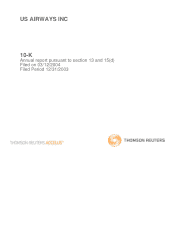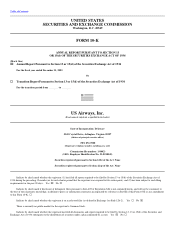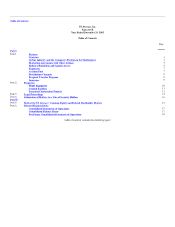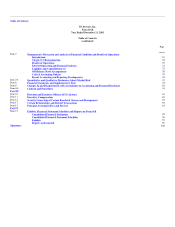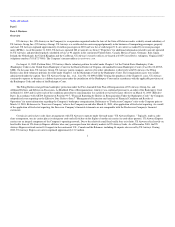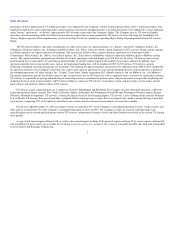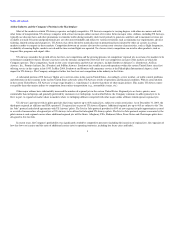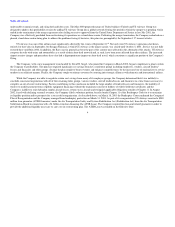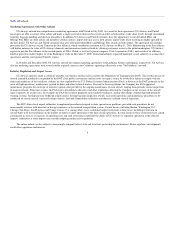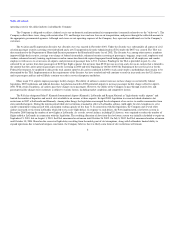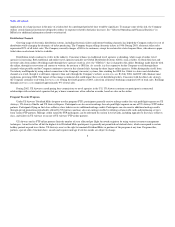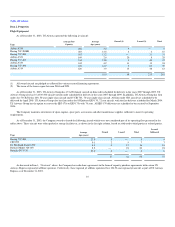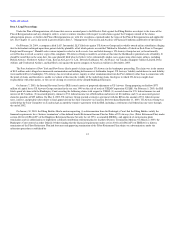US Airways 2003 Annual Report Download - page 8
Download and view the complete annual report
Please find page 8 of the 2003 US Airways annual report below. You can navigate through the pages in the report by either clicking on the pages listed below, or by using the keyword search tool below to find specific information within the annual report.
Table of Contents
Airline Industry and the Company's Position in the Marketplace
Most of the markets in which US Airways operates are highly competitive. US Airways competes to varying degrees with other air carriers and with
other forms of transportation. US Airways competes with at least one major airline on most of its routes between major cities. Airlines, including US Airways,
typically use discount fares and other promotions to stimulate traffic during normally slack travel periods to generate cash flow and to maximize revenue per
available seat mile. Discount and promotional fares are often non-refundable and subject to various restrictions such as minimum stay requirements, advance
ticketing, limited seating and change fees. US Airways has often elected to match discount or promotional fares initiated by other air carriers in certain
markets in order to compete in those markets. Competition between air carriers also involves certain route structure characteristics, such as flight frequencies,
availability of nonstop flights, markets served and the time certain flights are operated. To a lesser extent, competition can involve other products, such as
frequent flier programs and airport clubs.
US Airways considers the growth of low-fare low-cost competition and the growing presence of competitors' regional jets in certain of its markets to be
its foremost competitive threats. Recent years have seen the entrance and growth of low-fare low-cost competitors in many of the markets in which the
Company operates. These competitors, based on low costs of operations and low-fare structures, include Southwest Airlines Co. (Southwest), AirTran
Airways, Inc., Frontier Airlines, Inc. (Frontier) and JetBlue Airways. Southwest has steadily increased operations within the eastern United States since first
offering service in this region in late 1993. In May 2004, Southwest and Frontier will commence service at the Philadelphia International Airport, a hub
airport for US Airways. The Company anticipates further low-fare low-cost competition in the industry in the future.
A substantial portion of US Airways' flights are to or from cities in the eastern United States. Accordingly, severe weather, air traffic control problems
and downturns in the economy in the eastern United States adversely affect US Airways results of operations and financial condition. With its concentration
in the eastern United States, US Airways' average stage length (i.e., trip distance) is shorter than those of other major airlines. This makes US Airways more
susceptible than other major airlines to competition from surface transportation (e.g., automobiles, trains, etc.).
Other major airlines have substantially increased the number of regional jets in the eastern United States. Regional jets are faster, quieter, more
comfortable than turboprops and generally preferred by customers over turboprops. As described below, the Company continues to add regional jets to its
fleet, in part, to regain lost market share in markets where its turboprop affiliates competed with other major airline affiliates which operate regional jets.
US Airways' agreement with its pilots provides that it may operate up to 465 regional jets, subject to certain restrictions. As of December 31, 2003, the
third-party regional jet affiliates and PSA operated 113 regional jets as part of US Airways Express. Additional regional jets up to 465 are subject to the "Jets
for Jobs" protocol and related agreements with US Airways' pilots. The Jets for Jobs protocol provides for 50% of new regional jet pilot opportunities created
as a result of increased use of regional jets at US Airways to be offered to furloughed US Airways pilots. The Jets for Jobs protocol requires consensus by the
pilots union at each regional carrier where additional regional jets will be flown. Allegheny, PSA, Piedmont, Mesa, Trans States and Chautauqua pilots have
all agreed to Jets for Jobs.
In recent years, the Company's profitability was significantly eroded by competitive pressures (including the incursion of regional jets, the expansion of
low-fare low-cost carriers and the entry of additional carriers into its operating territories, including key focus cities and hubs),
3

